Subscribe now and get the latest podcast releases delivered straight to your inbox.
Mission Statement Examples
- Sweetgreen: To inspire healthier communities by connecting people to real food.
- Le Creuset: Le Creuset is focused on inspiring and empowering people everywhere to make joy through cooking.
- Sperry: To ignite the human spirit through the power of sea-based discovery and adventure.
- Spotify: To unlock the potential of human creativity—by giving a million creative artists the opportunity to live off their art and billions of fans the opportunity to enjoy and be inspired by it.
- Patagonia: Build the best product, cause no unnecessary harm, use business to inspire and implement solutions to the environmental crisis.
- GE: To invent the next industrial era, to build, move, power and cure the world.
- Trek: To aid in the betterment of our planet through cycling.
- TED: Spread ideas.
- Stitch Fix: To change the way people find clothes they love by combining technology with the personal touch of seasoned style experts.
- Nike: To bring inspiration and innovation to every athlete in the world.
- Framebridge: To make it easy for you to tell your story by framing the things you love.
- Etsy: Keep commerce human.
- Apple: Apple strives to bring the best personal computing experience to students, educators, creative professionals, and consumers around the world through its innovative hardware, software, and internet offerings.
- Blueland: To make it easy for everyone to be environmentally responsible.
- Google: Our mission is to organize the world’s information and make it universally accessible and useful.
- Herman Miller: Inspiring designs to help people do great things.
- Cariuma: Our mission has been to make things in a way that’s better for people and the planet. It’s a journey. We are constantly evaluating and evolving our processes to be greener than they were the day before.
- Ben & Jerry’s: Our Economic Mission asks us to manage our Company for sustainable financial growth. Our Social Mission compels us to use our Company in innovative ways to make the world a better place. Our Product Mission drives us to make fantastic ice cream – for its own sake.
- HubSpot: We believe businesses can grow with a conscience, and succeed with a soul — and that they can do it with inbound. That's why we've created a platform uniting software, education, and community to help businesses grow better every day.
- Tesla: To accelerate the world’s transition to sustainable energy.
- MakeUp Eraser: MakeUp Eraser is dedicated to creating the most sustainable makeup removal product in the world by using only the most accessible resource available: WATER. We truly believe we can eliminate the 3rd most wasteful product in the world: WIPES.
My first paying job was babysitting some of the kids around our suburban Chicago neighborhood.
As far as kids go, they were relatively decent little humans. And I was a pretty good babysitter who liked to play games, was a pro at cooking up some Kraft mac ‘n cheese, didn’t get flustered when a certain family dog locked us all out of the house (true story!), and really couldn’t get distracted by anything because I didn’t have a cell phone yet.
But the one thing that broke me time and again was the ubiquitous childhood go-to question: Why?
Anyone who’s spent more than five minutes with a three-year-old knows this question well, and you probably also know that the answer doesn’t always come easily.
While we may be able to muddle our way through explanations to a toddler, when we have to explain the why behind our business, things certainly can get trickier.
If you’re in the process of writing a company mission statement, you’re deeply embroiled in the why of your organization and you’re likely realizing:
There’s an art to writing an effective mission statement.
Not only should it speak to and inspire your audience, but it should guide and motivate your employees, and explain why you do what you do.
Before you get down to brass tacks, though, it’s important to understand, well, why you’re doing this in the first place.
What exactly is a mission statement?
A mission statement is a declaration of the guiding principles of a company.
It’s the driving force behind everything you do, from the daily tasks to the big, hairy audacious goals. It’s the call-to-action for everyone in your company and it lets the external world in on your vision.
That’s a lot to pack into just a few words.
But don’t worry; You don’t necessarily need to include everything in your statement.
Mission statements work in tandem with a company’s purpose and values, helping define corporate culture and how a brand interacts within its walls and with the outside world.
(The other branding element in your arsenal is the value proposition, which, as an explanation that speaks directly to your target audience as to why you’re unique, is a more salesy cousin to the mission statement.)
🔎 Related: How to Write a Mission Statement for Your Business
For example, here at IMPACT, we have a mission statement, a purpose, and core values.
I’ve already talked about the mission statement being the why of your company. Your purpose and values, then, are the what and the how. Let’s take a look at how those three play together at IMPACT:
Mission statement = WHY we come to work every day
To be the #1 teacher in the digital sales and marketing space for growth-focused businesses and digital sales and marketing professionals.
Purpose = WHAT we create if we follow the mission
Creating heroes, growing business, changing lives.
VALUES = HOW we create an atmosphere to fulfill our mission
Candor over comfort.
Embrace the pace.
Feedback is a gift.
Fulfill our promises.
Live in the solution.
Question first.
Rooted in self-awareness.
Does all this mean that your company needs to go all-in on a purpose statement, a mission statement, and a handful of core values?
Only if you want to. It’s, literally, your business what path you take to spreading the word about why you do what you do.
That said, brands of all shapes, sizes, and values have created brilliant mission statements by staying true to themselves and defining what drives them.
Whether you’re new to the mission statement game and crafting one from scratch, or if you’re reworking an existing statement to better reflect your brand’s purpose for these changing times, a review of some powerful mission statement examples can help spark a creative flame.
🔎 Related: What is a content marketing mission statement? (+ how to create one)
Here are 21 of my favorite mission statements to inspire you:
1. Sweetgreen

The mission: To inspire healthier communities by connecting people to real food.
Why it works: This is a case where nearly every word in the statement plays a key role.
Health-food provider Sweetgreen digs deeper than merely relating what it does and connects its mission to how it sources and prepares meals while working to improve the communities in which its restaurants are located.
With sustainability and transparency as part of Sweetgreen’s “food ethos”—the company actually lists the local farms it uses next to an ingredients list. It has also partnered with the ASPCA to improve animal welfare—they’ve definitely gone all-in on its “real food” pledge.
By doing this, Sweetgreen is defining their why and closely tying its mission both to its values and to those of its audience.
2. Le Creuset

The mission: Le Creuset is focused on inspiring and empowering people everywhere to make joy through cooking.
Why it works: Le Creuset provides cookware for the at-home chef, but its mission statement is speaking to how it wants its audience to feel: empowered and joyful.
In its About page, the company talks about how cooking has evolved from a necessity to a “pursuit of pleasure.” And, for its more affluent customer base, Le Creuset provides the right tools for the job when it comes to creating and serving meals at home.
3. Sperry
The mission: To ignite the human spirit through the power of sea-based discovery and adventure.
Why it works: Sperry does a good job of defining the parameters (“sea-based discovery”) within which it operates. This narrow focus also helps to define its audience and connects back to the company’s roots.
Notice that it also doesn’t mention its product at all.
The company, founded by a sailor looking for footwear that provides traction on a boat deck, sells shoes and clothing to those who certainly look like they just stepped off a boat (without slipping).
The idea of “sea-based discovery and adventure” tracks to the type of clothing it provides, but focuses on the values of its audience and the outcome of using the product, as opposed to the product itself.
4. Spotify
The mission: To unlock the potential of human creativity—by giving a million creative artists the opportunity to live off their art and billions of fans the opportunity to enjoy and be inspired by it.
Why it works: Spotify’s mission starts out esoteric—unlocking the potential of human creativity is a lofty goal—but takes an extremely specific and guided turn.
This works because Spotify serves two distinct groups—artists and listeners—and clearly demonstrates its value to both in its statement.
The big-picture opener appeals to everyone, while the specificity demonstrates how we might see ourselves fitting into one group or the other, or both.
5. Patagonia

The mission: Build the best product, cause no unnecessary harm, use business to inspire and implement solutions to the environmental crisis.
Why it works: Patagonia's mission statement lays out exactly what it does and what the public can expect from it.
While the organization may attract criticism when it makes a political statement, its mission statement makes no secret of what it stands for.
Patagonia’s actions and value have a direct correlation to its mission.
The sporting goods provider is famously known for environmental protection and taking a stand to fight climate change, and it backs this up by donating 1% of its sales to grassroots environmental groups and engineering its stores and products to leave a minimal footprint.
6. GE

The mission: To invent the next industrial era, to build, move, power and cure the world.
Why it works: It’s very possible that what you do is also why you do it. If that’s the case, there’s no need for embellishment.
GE’s statement keeps it simple by defining exactly what it does, even when what it does is extremely diverse.
GE’s scope of technology and machinery ranges from power and healthcare to aeronautics, and so “build, move, power and cure,” while seemingly specific, relates to the large span of its offerings.
Like Spotify does, GE also begins a rather specific statement with a more inspirational overview. “To invent the next industrial era” connects the mission with GE’s spirit of innovation.
7. Trek

The mission: To aid in the betterment of our planet through cycling.
Why it works: Trek’s statement works well on three levels.
First, it keeps it simple. As a creator of bicycles and cycling apparel and accessories, there’s little ambiguity into what Trek does when it puts the word “cycling” up front in its mission statement.
Second, with the lead in of aiding “in the betterment of our planet,” Trek is defining what drives it. Scroll through the company’s website, and you’ll learn that it believes “the bicycle is a simple solution to the world’s complex problems.”
Trek’s actions support this with heavy involvement in social responsibility and sustainability. It’s involvement with organizations like DreamBikes “provides teens in disadvantaged neighborhoods with hands-on, paid job training to open up future employment opportunities and make a difference in their lives.”
In addition to building green facilities and working to reduce production waste, Trek has also worked to restore the native forest around its headquarters.
Trek’s mission statement is consistent with its values and actions and by doing so stays true to itself. Consumers reward companies that are authentic and will notice when a company takes action that goes against its mission. Trek shows that it practices what it preaches.
8. TED

The mission: Spread ideas.
Why it works: Does it get simpler than this? The database on TED.com is full of thousands of short talks covering any topic imaginable and delivered in more than 100 languages.
For a non-profit known for its concise keynotes (every talk is 18 minutes or less), just two words are perfectly appropriate.
9. Stitch Fix

The mission: To change the way people find clothes they love by combining technology with the personal touch of seasoned style experts.
Why it works: Stitch Fix handles the clarity of what it does and the reasons behind it.
There’s no ambiguity here to its purpose or what it does.
With a mission that’s simple and direct, Stitch Fix keeps the focus on helping people find the right fit and style and stays true to itself.
10. Nike
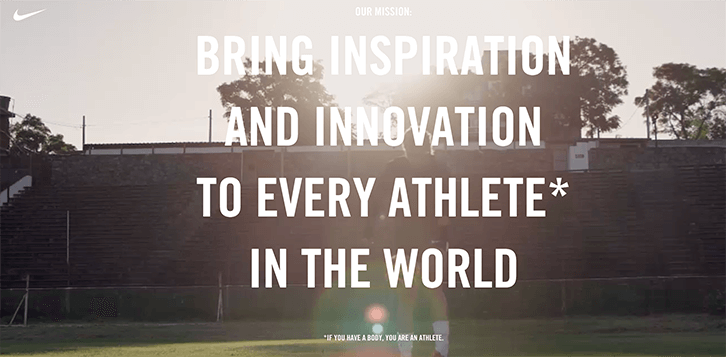
The mission: To bring inspiration and innovation to every athlete in the world.
Why it works: Nike’s mission both tells the story of what the brand does and sets the bar for future corporate strategy.
The statement is broad and leaves space for interpretation, but also reflects the values and purpose Nike adheres to.
The company further explains, “Our mission is what drives us to do everything possible to expand human potential. We do that by creating groundbreaking sport innovations, by making our products more sustainably, by building a creative and diverse global team and by making a positive impact in communities where we live and work.”
11. Framebridge

The mission: To make it easy for you to tell your story by framing the things you love.
Why it works: Framebridge defines its mission by speaking directly to its audience (and making us feel special in the process).
It addresses a problem its customers have (difficulty framing things) and solves for it.
This is another example of a statement that’s simple and defines what the brand does, but its personal approach is especially compelling.
By framing the statement in the second person, Framebridge gives anyone reading their mission the potential to see themselves as a customer.
12. Etsy

The mission: Keep commerce human.
Why it works: Retail platform Etsy combines simplicity with its purpose to build a statement that can guide the brand’s strategy while appealing to its customers. The statement, as Etsy puts it, does double-duty: “It guides our day-to-day decisions while inspiring us to think big for the long term.” The juxtaposition of “commerce” and “human” spins a rather cold word with the personal. By doing this, Etsy is setting up the perceived problem—that the business world can be impersonal and scary—so that it can solve it by making it approachable.
13. Apple

The mission: Apple strives to bring the best personal computing experience to students, educators, creative professionals, and consumers around the world through its innovative hardware, software, and internet offerings.
Why it works: Apple’s mission is straightforward — clearly explaining what it does and who its customers are — while still leaving room for some aspiration. The litmus test here is bringing “the best personal computing experience” to its audience.
I like the mix of inspiration with a clear approach. However, it’s not necessarily obvious that this is the company’s mission statement, as it appears solely on the Product Feedback page of the website.
If you’ve gone to the length of defining and perfecting your mission, make the statement easily found on your website. (You could, dare I say, even brag about it!)
14. Blueland
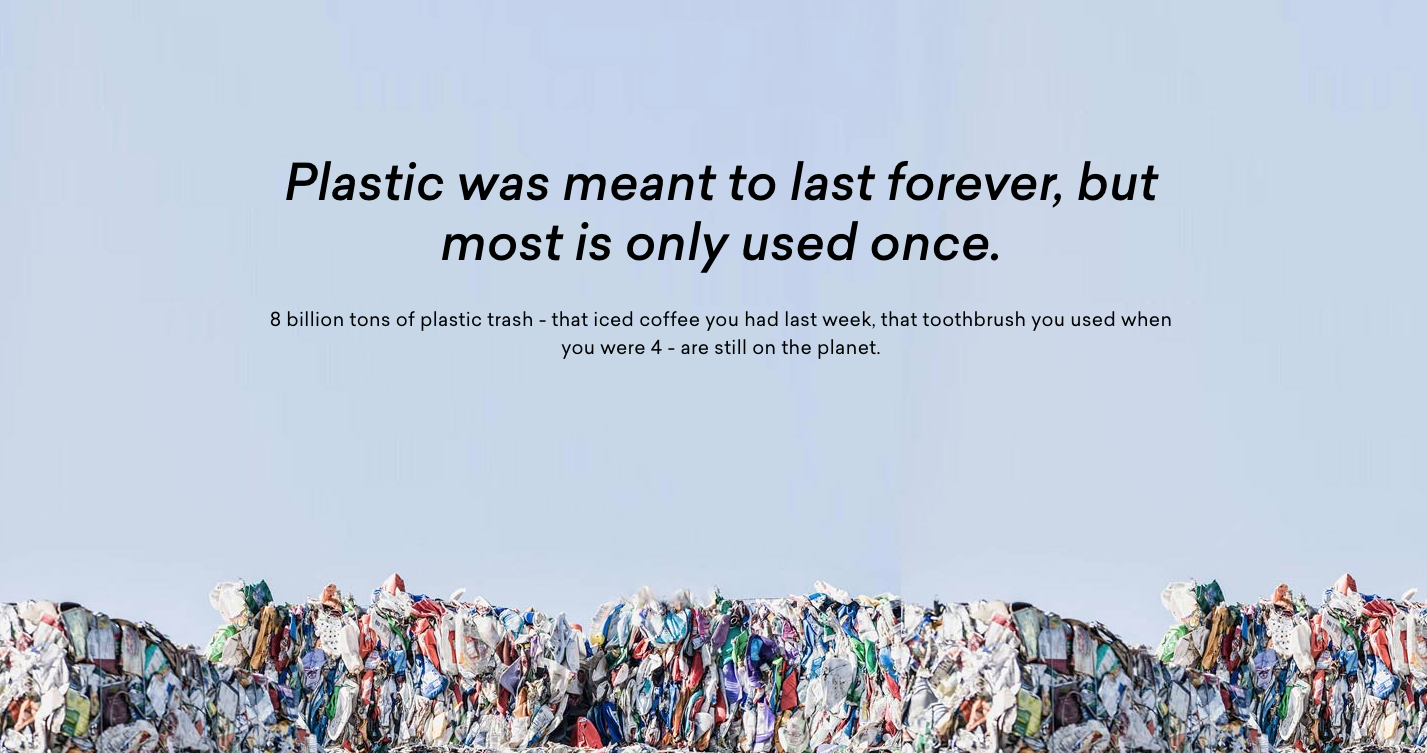
The mission: To make it easy for everyone to be environmentally responsible.
Why it works: Blueland’s eco-friendly approach to product packaging is woven into every page of its website, and it shines brightest on its “Our Mission” page.
The New York City-based company provides cleaning products in sustainable and or reusable packaging to eliminate single-use plastic. Why is this important? The site lists this detail that I cannot shake: “8 billion tons of plastic trash — that iced coffee you had last week, that toothbrush you used when you were 4 — are still on the planet.” Yikes.
In its statement, Blueland is clear about what it stands for. While the mission statement itself is more high-level, the company gets more specific in its purpose statement: “To make being eco easy with innovative products in reusable packaging that are convenient, effective and affordable.”
15. Google
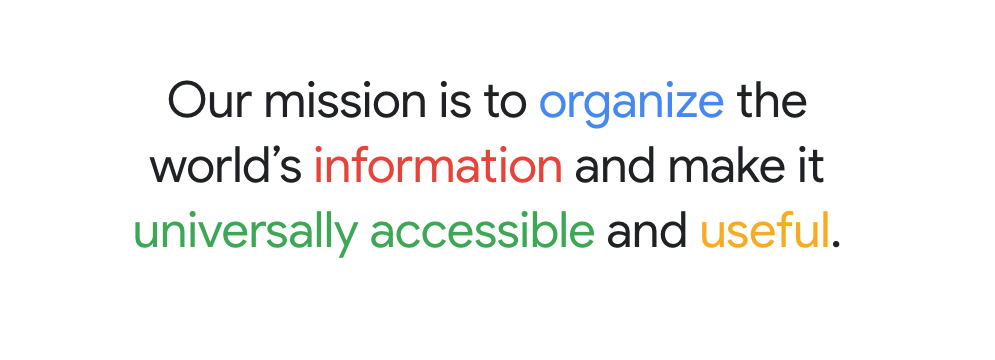
The mission: Our mission is to organize the world’s information and make it universally accessible and useful.
Why it works: The first half of Google’s mission defines what the company does — “organize the world’s information” — while the pledge to make that information “universally accessible and useful” provides the social vision the company wants to achieve.
When your own brand has become the generic verb for what you do, do you even need a mission statement? Clearly, yes.
No matter the success of your brand — or perhaps because of such large-scale popularity — a mission statement is crucial to keep the bigger picture in front of employees, advertisers, ambassadors, and everyday users.
16. Herman Miller

The mission: Inspiring designs to help people do great things.
Why it works: Furniture manufacturer Herman Miller is known for its timeless designs, so it’s no surprise its mission statement focuses on the people affected by such inspiration.
This is a case where the mission, the why, is separated from the company’s values, as a corporate statement explains:
The mission is built on the values that define the company and are expressed as “the things that matter.” These values include curiosity and exploration, design, performance, engagement, inclusiveness, relationships, transparency, cultural foundations, and a collective commitment to making a better world.
17. Cariuma
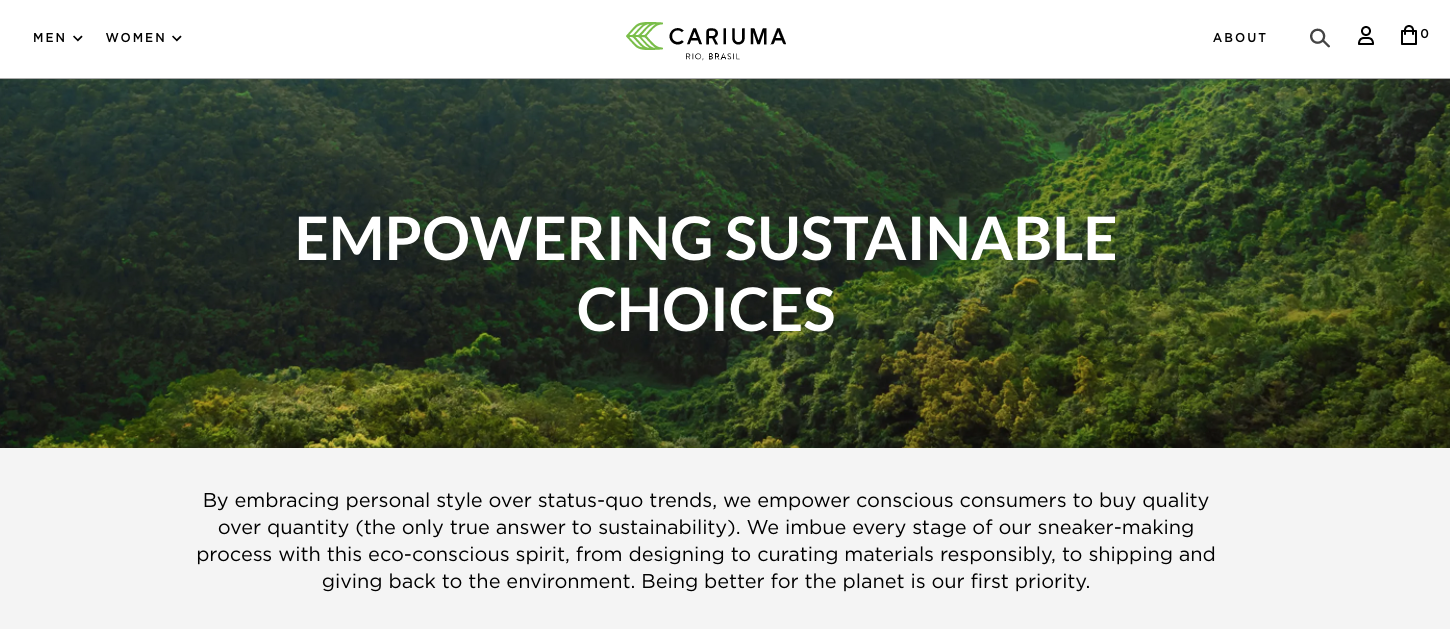
The mission: Our mission has been to make things in a way that’s better for people and the planet. It’s a journey. We are constantly evaluating and evolving our processes to be greener than they were the day before.
Why it works: Shoe manufacturer Cariuma’s mission takes a hybrid approach. It uses its statement to explain its mark on the planet as well as how it put its mission into action.
This is also a much more conversational statement than you might be used to seeing. With this, the company is expressing both what defines it as a brand and what tone its company culture has. Don’t be afraid to do this! Show more of who your brand is, as long as it's consistent with your overall company personality.
18. Ben & Jerry’s

The missions:
- Our Economic Mission asks us to manage our Company for sustainable financial growth.
- Our Social Mission compels us to use our Company in innovative ways to make the world a better place.
- Our Product Mission drives us to make fantastic ice cream – for its own sake.
Why it works: Just like one pint of ice cream is never enough from Ben & Jerry’s, neither are its mission statements. The dessert guru breaks its mission into three segments, which helps specifically define the most important driving elements of the business.
This approach might work best for you if you’re having trouble fitting what’s most prioritized into a single statement and if you find that you have distinct missions for each part of your business.
19. HubSpot
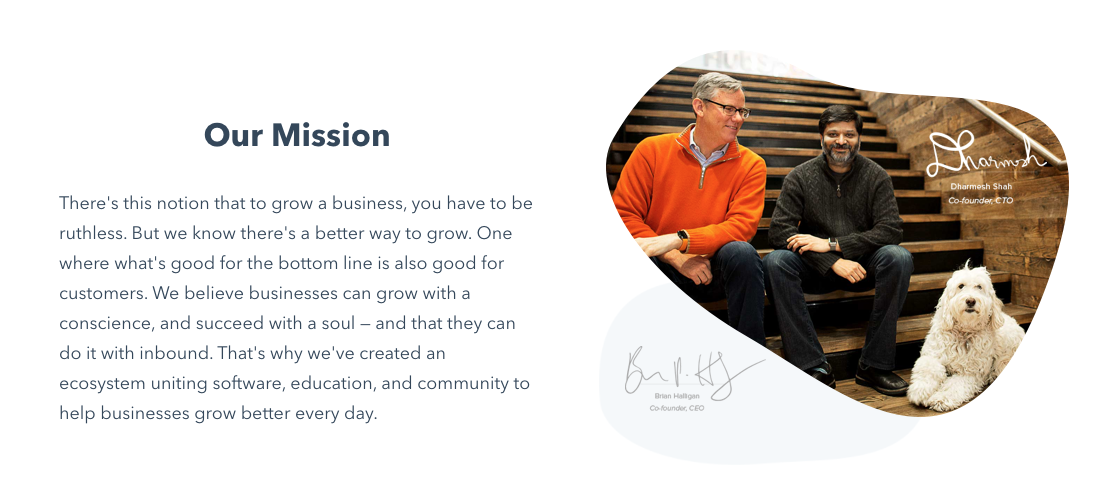
The mission: We believe businesses can grow with a conscience, and succeed with a soul — and that they can do it with inbound. That's why we've created a platform uniting software, education, and community to help businesses grow better every day.
Why it works: Yes, HubSpot’s mission is more of a belief statement, but it identifies the why behind what it does: “to help businesses grow better every day.”
This Boston-based software company is certainly no stranger to the inbound marketer (heck, HubSpot CEO and co-founder Brian Halligan coined the term “inbound”), whether you know it from using its software, taking its free certification courses, or being active in its massive community. And so HubSpot acknowledges how its clients and ambassadors use the brand right in the mission statement. This makes its audience part of the statement itself.
20. Tesla

The mission: To accelerate the world’s transition to sustainable energy.
Why it works: Car manufacturer Tesla (and CEO Elon Musk) are known for being bold, and their mission statement reflects the brand’s ambitious attitude. In this case, the company opts to not mention what it does but instead shows the outcome of what success looks like for the company.
If your brand is driven by a single big, hairy, audacious goal, make that goal your mission.
21. MakeUp Eraser
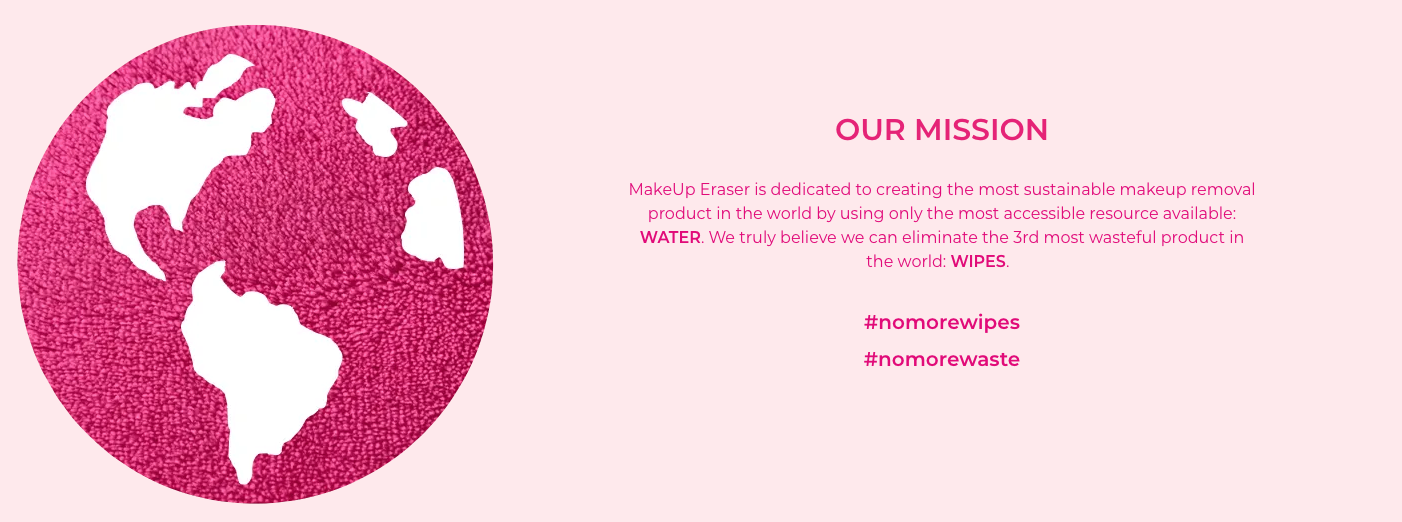
The mission: MakeUp Eraser is dedicated to creating the most sustainable makeup removal product in the world by using only the most accessible resource available: WATER. We truly believe we can eliminate the third most wasteful product in the world: WIPES.
Why it works: As an eco-friendly brand, MakeUp Eraser makes it clear what they do in their statement. Then they double-down on their social responsibility.
Buyers, especially Gen Zers, prioritize social responsibility when it comes to making purchasing decisions. And nearly two-thirds of consumers are likely to buy from a business based on a brand’s social position. If your company is making a social statement in action, then backing that up with a written mission could equate to more customers — and more customer loyalty.
Creating a mission statement that sets an example for others
As you sit down to write or revise your own mission statement, you may find your company’s purpose and values are so deeply intertwined in the mission that they can’t be untangled.
In the examples above, you may have noticed there are several companies that have clear overlap between the three: mission, purpose, and values. If you’re able to write a statement that
- defines what drives you,
- is true to what you stand for,
- is clearly communicated,
then you don’t need to worry about whether your mission statement follows the rules. You do, however, need to have one in whatever form it may take.


Order Your Copy of Marcus Sheridan's New Book — Endless Customers!


